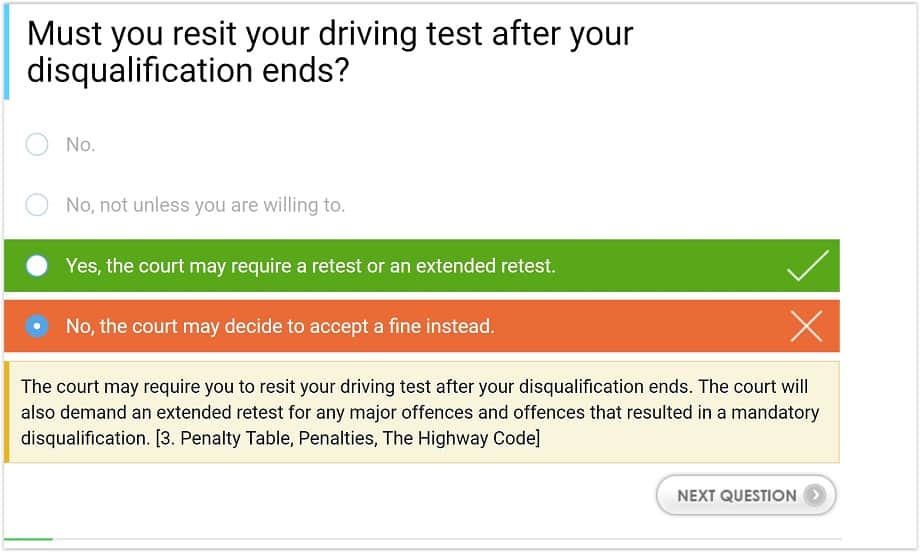It happens to many of us. There’s no warning sign, no obvious flaw in your preparation and no comfort beyond an “Ah, better luck next time mate” when the time comes. We’re talking, of course, about failing your driving theory test.
When I failed my theory test years ago, I was devastated. All of my mates had passed first time, full marks on all the questions with barely a glance at the highway code. If you’ve just had a bad result on test day, you might feel a bit cheated. You looked at the sample questions, plus, when you think about it, the system is flawed and the questions aren’t always clear and this and that…
Excuses. The fact is, with enough practise and effort, you will pass your theory test second time around. While there is no single reason why you keep failing the theory test, better preparation is one thing you can do to pass the next time. Let’s walk through how to get back on top of your game and breeze through the next test.
1
First Things First: Book Another Test
The last thing we want to face after failure is that enemy which just defeated us. However, your earliest slot could be anywhere from a couple of days to several weeks.
It’s possible to book another theory test more or less immediately after learning you’ve failed. However, rules state you’ve got to wait a full 72 hours before taking it again. Even if you’re able to make a reservation this soon (many test centres have a waiting list), it might be advisable to cool your heels for a while, wait a couple of weeks, and take the time to reflect and revise. As each test costs £23 to take, the cost of repeated unsuccessful attempts can soon add up.
If possible, give yourself two weeks: enough time to stay focused, but short enough that it shouldn’t affect your planned practical test date.
2
Look at the feedback
If you encountered problems during the multiple choice section of the theory test, it’s good to know that you will be given feedback on the questions you failed to answer correctly. In some cases, you may notice a recurring theme, where all of the questions you got wrong fall into one area — such as road signs or braking distances.
This is the information you need to take heed of the most, as it can be your golden ticket to a better result the second time round. Although it’s unlikely you’ll get the exact same questions, they’ll cover an equally broad range of topics.
Unfortunately, owing to the video-based format of the hazard perception part of the theory test, no detailed feedback as such is given on where you went wrong here. However, if you clicked too early or too late, it’s likely you’ll realise the error yourself.
Get the Best Resources
This doesn’t mean spending £20 an hour on a Theory Test Coach (they probably don’t exist anyway) but rather:
- Obtaining an up-to-date edition of The Highway Code.
- Making use of mock tests to practice.
Using the Highway Code
This is not a guide to the test, nor is it set out in a question-answer format. It is, however, an easy-to-read catalogue of everything you need to pass your test, and drive safely. Read the highway code through, once (it won’t take long) and then use it as reference material when doing your mock tests. Speaking of…
Making the Most of Mock Tests
There are over 17 free mock tests on our site right now. Once you’ve read your Highway Code, try one out. The most important thing here is to not be discouraged if you fail. If you knew everything already, you’d have passed without thinking the first time around.
The best thing about our mock tests is that they give you instant feedback on your answer. Get it right, and we elaborate on the answer. Get it wrong, and we explain the correct response simply and clearly. After learning why an answer is right or wrong, you’ll be able to remember it in future.

The explanation is given both to correct and incorrect answers (Free Mock Tests)
3
Practise Time Management
In some cases, it won’t have been your theoretical knowledge which caused the issue. It’s a sad truth that some of us just aren’t that good in exam rooms. And when you see a clock slowly ticking down, and you feel like you’re up against it, the stress can prove an immense distraction.
There are 50 points available in the multiple choice part of the theory test, and you need 43 to pass. As you have 57 minutes, this equates to approximately 70 seconds per point. Try timing yourself to see whether you can keep to this pace — and most importantly, never dwell on a question you find particularly difficult. You’re better off moving on and focusing your energy on the questions you can get right.
4
Get Out on the Road
Questions are only half the battle. Hazard perception can’t be trained with a book, so you’ll need some practical experience.
Ask your friends/parents/neighbours to let you ride shotgun while they drive. Pretend you’re behind the wheel, and try to spot potential hazards (pedestrians, vehicles, sudden traffic etc.) as you go. You won’t get immediate, tangible results like with the mock tests, but it’s incredible how quickly the brain adapts to driving and your observation improves.
5
Enlist Examiners and Talk to Your Instructor
Hand someone a copy of the Highway Code and make them ask you questions. On anything. This is a brutal test, but if you’ve put in the hours studying and actively absorbing knowledge so far, you should do well.
Also, don’t be embarrassed to seek tips from your driving instructor when you next see them. They’re in a unique position because they will have seen your motoring capabilities and weaknesses first hand, and might be able to give you encouragement and tailored advice. The experiences of your friends and family can also be immensely helpful to draw off.
6
Try a Different Revision Technique
If you felt like you were just staring at the pages of a book in the run up to your test without soaking anything in, it might be time to change tack and move to a new method of learning. Thanks to the age of the smartphone and tablet, there are loads of interactive ways to absorb theory knowledge. Use the Theory Test Genius app on your iOS or Android.
7
Avoid “Cramming”
If you’ve given yourself two weeks, then 13 days of hard work is enough. Don’t spend the final day before the exam stressing and fretting, or staying up until 2am jamming stopping distances and speed limits into your tired brain.
Instead, spend the day relaxing, playing sports or watching TV. Just keep your brain away from the test; trust me, everything you’ve learned will still be there, and it will be even more accessible when you sit down, all relaxed, for your test.
8
Test-Day Preparation
You’ve already sat the test once, so there’s nothing to be nervous about. You know how the day goes, how quiet the room can be, how long it’s going to take. You have an advantage over everyone else, so use it. When they are busy fretting, take a few moments to get relaxed and comfortable in your chair.
9
A Final Word
The key difference between test 1 and test 2, is that you know the test won’t be a walk in the park. Every time you think hmm, maybe I’ll just skip studying tonight, remember how it felt when you found those questions that panicked you.
Put in two weeks of effort, reading the code and completing the mock tests as often as you can. When that’s done, walk confidently into the test centre, answer your questions, spot your hazards and then take your leave.
This time though, you’ll be leaving with a piece of paper which says “Congratulations. Now book your practical test.”
Good luck!

